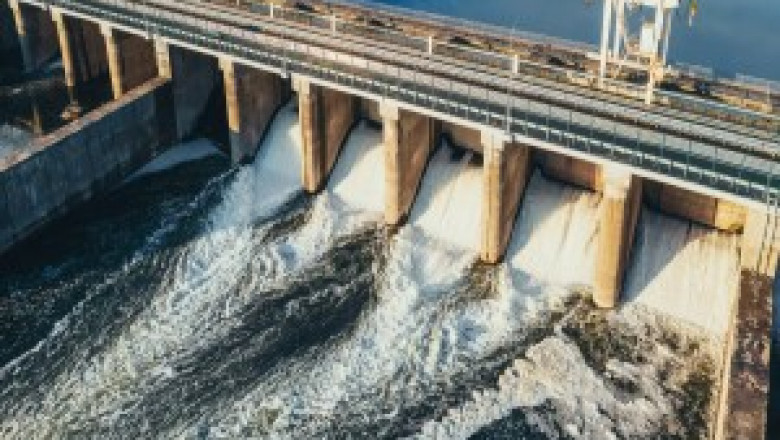views
Small hydropower, sometimes called run-of-the-river hydro, involves capturing the kinetic energy of flowing water using turbines to generate electricity on a small scale. While large-scale hydroelectric dams can power entire cities, small hydropower is well-suited for more localized power needs.
What is Small Hydropower?
Small hydropower refers to hydroelectric power that produces up to 10 megawatts of power. Some key aspects of small hydropower include:
- Runs-of-river systems: Small Hydropower use a portion of a river's flow through a turbine without the use of damming structures. Water is diverted through pipes or channels and passed through a turbine. The water is then returned directly to the watercourse downstream with little change in water flow or water levels.
- Low environmental impact: Compared to large-scale hydroelectric dams, small hydropower projects have a much smaller footprint and disruption of natural habitats. There is minimal flooding of land and less disruption of fish migration.
- Local power generation: Small hydropower can provide clean, renewable electricity on a community or regional scale. It is suitable for remote areas not connected to centralized electric grids. Excess power can be sold to energy utilities.
- Low costs: Once built, the fuel of water flow is free and there are no ongoing costs for fuel. Initial installation costs are on par with some other renewable technologies like ground source heat pumps. Operation and maintenance costs are also limited.
Benefits of Small Hydropower
Small hydropower offers several environmental and economic benefits compared to fossil fuel-based electricity:
Renewable energy source: Hydropower harnesses the natural power of flowing water to generate electricity without burning fossil fuels. As long as rivers flow, hydropower is a sustainable renewable resource.
No greenhouse gas emissions: Once constructed, small hydropower plants do not directly produce any of the primary greenhouse gases associated with climate change such as carbon dioxide, methane, or nitrous oxide.
Job creation: Installation and maintenance of small hydropower requires local hires of equipment operators, electricians, engineers and other construction workers, providing ongoing economic activity in rural communities.
Energy security: Locally produced hydropower can help communities gain greater energy independence and resilience against disruptions to centralized grid systems or rises in fossil fuel costs.
Grid support: Excess power from small hydropower can support regional electric grids by helping meet peak demand periods and offsetting use of diesel generator backups. This improves grid stability.
Potential for Growth
Despite these benefits, small hydropower remains an untapped renewable resource in many regions worldwide. Further development has potential to:
- Expand access to electricity: An estimated 770 million people worldwide still lack basic electricity access, many in remote, rural areas. Small hydropower is well-suited technically and economically to meeting some of this need.
- Increase climate solutions: Hydropower currently supplies over 15% of global electricity but large-scale potential is limited, leaving room for growth from small-scale additions. This can further reduce the carbon footprint of power sectors.
- Utilize undeveloped sites: Studies have shown hydro potential from undeveloped small sites that would have small environmental footprints. Tapping these could significantly boost total hydropower yields.
- Promote rural development: Small hydro projects require less capital than large dams yet offer local energy supplies and jobs in regions that need economic opportunities. This pairs renewable energy with community development.
- Improve energy resilience: Distributed small hydro network can enhance region's energy security by leveraging local water resources and requiring less transmission infrastructure.
Challenges for Growth
While small hydropower demonstrates many benefits, some challenges have slowed its development and growth potential, including:
- High initial costs: Upfront installation costs, though competitive for off-grid applications, are still significant relative to many other renewable options like solar. This requires supportive policies.
- Limited private investment: Project risks, long payback periods and smaller scales have made small hydro less attractive commercially without policy de-risking or incentives to mobilize capital.
- Grid integration complexities: Successfully incorporating variable hydropower into mixed grid systems reliant on other generation requires advanced planning, regulations and market structures.
- Environmental regulations: While impacts are smaller, compliance with regulations around habitat, water usage and flow levels still entails permitting complexities, studies and mitigation.
- Rural infrastructure needs: Achieving full development potential in remote regions requires expanded access roads, transmission lines and other infrastructure investments.
With suitable policy and financial support, the untapped potential of small hydropower could greatly contribute to global renewable energy and rural development goals. While challenges remain, overcoming barriers would mean tapping into a large source of indigenous renewable power. Small hydro deserves attention and support as part of comprehensive strategies towards sustainable energy and electricity access for all.
Get This Report in Japanese Language: 小水力発電
Get This Report in Korean Language: 소수력 발전
About Author:
Vaagisha brings over three years of expertise as a content editor in the market research domain. Originally a creative writer, she discovered her passion for editing, combining her flair for writing with a meticulous eye for detail. Her ability to craft and refine compelling content makes her an invaluable asset in delivering polished and engaging write-ups.
(LinkedIn: https://www.linkedin.com/in/vaagisha-singh-8080b91)






















Comments
0 comment